The cruise with the Valdivia in spring 1990 has been organised by the Institute of Oceanography at the University of
Hamburg. On this cruise a new type of CTD has been be tested and the overflow of deep Greenland Sea and Island Sea water over
the Greenland and Island Ridges have been measured. Moreover a relative large number of students could get experiences in the usage of
oceanographic measurement methods and in the organisation of a scientific cruise.
The scientific background of this cruise was the detection of an active overflow of a deep watermass over the shallow ridges in the North Atlantic.
These ridges separate the deep Island and Greenland Sea from the deep North Atlantic. Due the cooling of surface water in the Greenland Sea
and due to mixing processes in the Island Sea cold and dense water is formed. The deep basins in the north are filled
up to this ridge with this heavy water. Under special conditions, when the basin is overfilled this water flows over the shallow
ridge into the deep north Atlantic and forms there the North Atlantic Intermediate Water. This process does not
occur regularly and therefore a little bit of luck is necessary to detect this water with the CTD over the ridge.
Click on thumbnails to see the pictures in full size.
Cruise | Explanation | Thumbnail |
| Valdivia cruise 1990 | The FS Valdivia on river Elbe, has been photo taken from the Strandperle in Hamburg. | 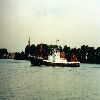 |
| Valdivia cruise 1990 | Valdivia, immediately before the cruise has been started at the famous Landungsbrücken in Hamburg. | 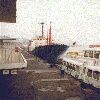 |
| Valdivia cruise 1990 | From Hamburg, down the river Elbe a pilot was on board, in the German Bight he left the ship. | 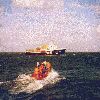 |
| Valdivia cruise 1990 | One of the few days at the beginning of the cruise, when we had good weather has been used for the preparation of the equipment. | 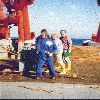 |
| Valdivia cruise 1990 | This is the new type of high speed CTD. Due to it's compact size it allows very fast winch velocities and very short deployment times. Moreover the CTD can be deployed even when the ship is moving with a velocity of 3-5 knots. | 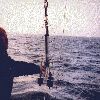 |
| Valdivia cruise 1990 | We had several days of extremely bad weather, especially in the north Atlantic, but also during the passage through the North Sea. This picture has been taken during a storm with more than 11 Beauford from the bridge. |  |
| Valdivia cruise 1990 | This is not the captain, it is a friend of mine - Robby who is watching the sea from the bridge. | 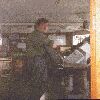 |
| Valdivia cruise 1990 | After deployment, the high speed CTD has to be stored inside the laboratory to read out the measured temperature, salinity and pressure data form the internal memory. | 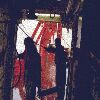 |
| Valdivia cruise 1990 | The CTD is already prepared for the next deployment, we were waiting of the notice from the bridge that the position of the station has been reached. | 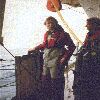 |
| Valdivia cruise 1990 | The bottles are filled after deployment and the CTD is back on deck again. This is a picture of the standard CTD with water sampling bottles around it. During the deployment these bottles can be filled in specific water depth to get probes for manual salinity detection later in the laboratory to calibrate the CTD sensors. Moreover the sampled water can be used for micro plankton monitoring or for nutrient measurement. In contrast to the high speed CTD the temperature and salinity profiles can be viewed during deployment. | 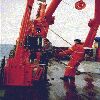 |
| Valdivia cruise 1990 | It is not really a kind of fun to work with water with a temperature of about 1°C. | 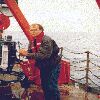 |
| Valdivia cruise 1990 | Bottles for the manual salinity detection were filled with water from the 10 litre sampling bottles immediately after deployment. These probes where used to calibrate the salinity values of the CTD later in the laboratory. | 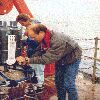 |











